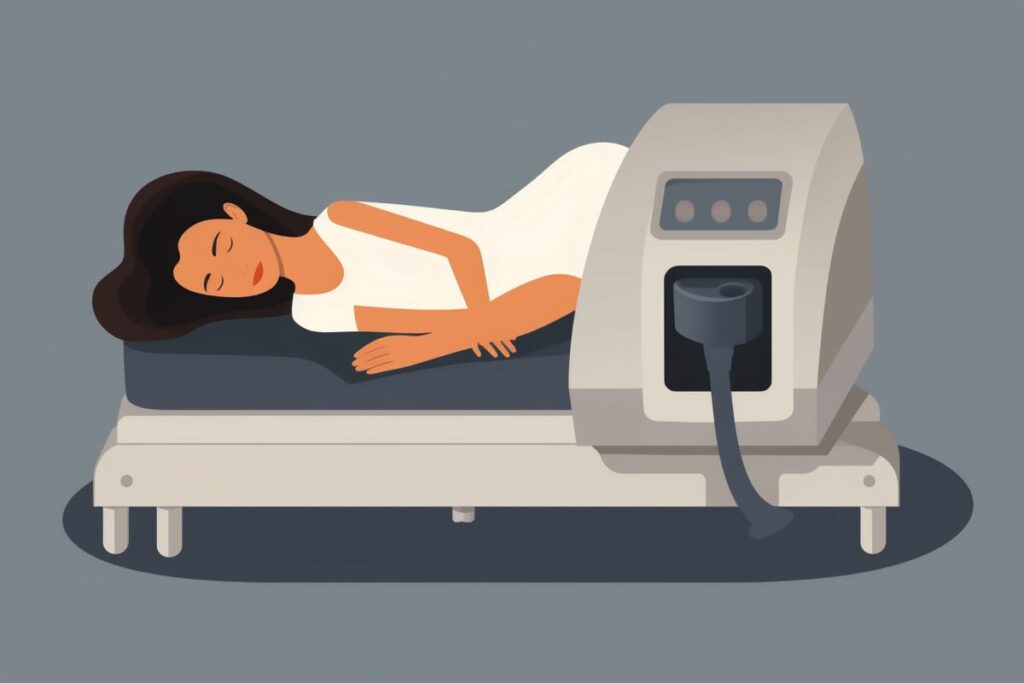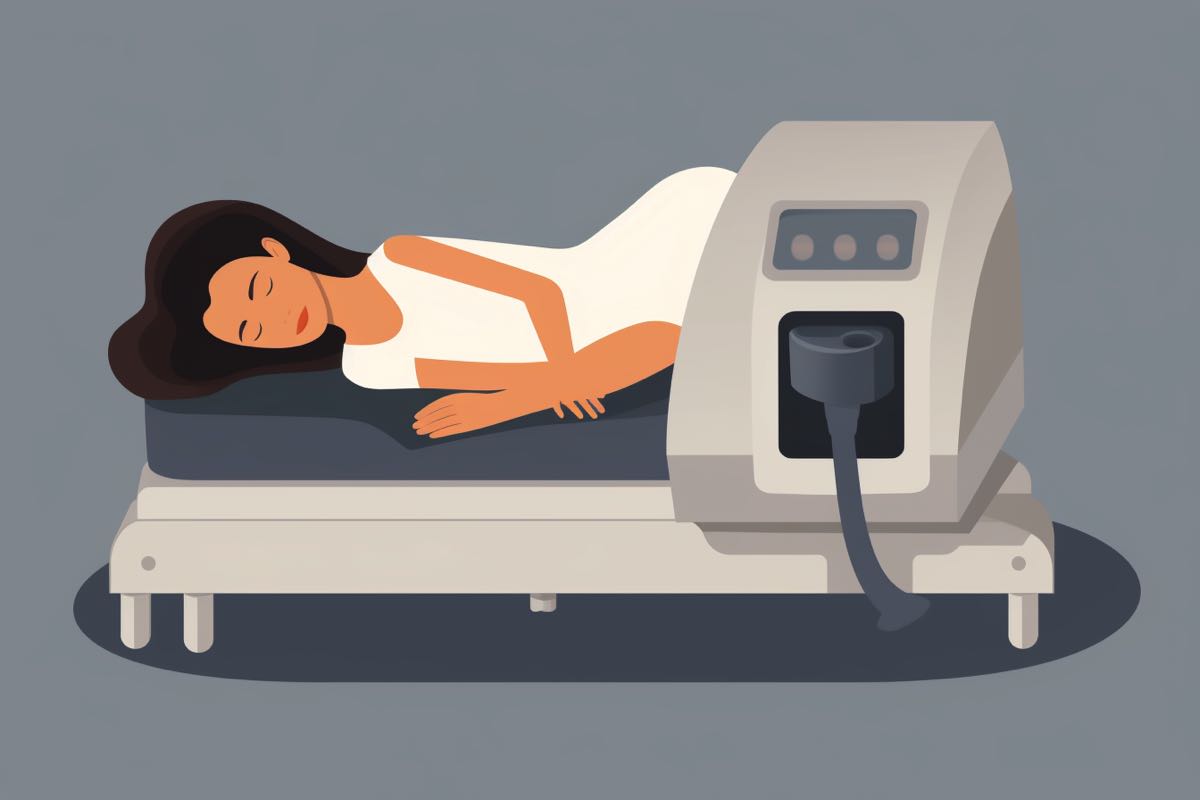As a fellow sleep enthusiast, I know how important it is to get a good night’s rest. Waking up feeling refreshed and energized sets the tone for our entire day! However, for those suffering from sleep apnea, getting that much-needed shut-eye can be quite the challenge.
You might have heard about or even tried using Continuous Positive Airway Pressure (CPAP) as a treatment option, but let’s face it—it’s not everyone’s cup of tea. The bulky mask, constant air pressure, and noise can make it hard to fall asleep in the first place.

But don’t you worry, my sleep-loving friends! There are other ways to treat sleep apnea without having to resort to CPAP therapy. In this article, we will explore alternative treatments and lifestyle changes that can help you breathe easier during your slumber and ultimately improve your overall quality of life.
So snuggle up with your favorite pillow and let’s dive into these non-CPAP solutions for sleep apnea!
Exploring Oral Appliances
As a sleep enthusiast, I can’t help but get excited about the various oral appliance benefits for treating sleep apnea without the need for CPAP!
These nifty little devices work by holding the jaw in a forward position, which helps to keep the airway open during sleep.
What’s great about them is that they’re non-invasive and often more comfortable than wearing a bulky CPAP mask.
Plus, with so many customization options available, you can find an oral appliance that’s tailored to your specific needs.
One of the best parts about using an oral appliance is that it can be adjusted to provide just the right amount of support for your jaw.
This means that as you become more accustomed to wearing it, you can fine-tune its fit to maximize both comfort and effectiveness.
It’s this combination of personalization and convenience that makes oral appliances such an attractive option for those of us who want to treat our sleep apnea without having to rely on CPAP machines.
So why not explore these wonderful devices and give yourself (and your partner) a peaceful night’s rest?
Embracing Lifestyle Changes
As we’ve just discussed, oral appliances can be a great alternative to CPAP machines for treating sleep apnea. But let’s not stop there! Another approach to consider is making some simple yet powerful lifestyle changes that can improve your sleep quality and overall health. Let’s dive into these fabulous options!
One of the best ways to treat sleep apnea without relying on machines or devices is by embracing a healthier lifestyle. Here are some key areas to focus on:
- Healthy Diet: Consuming a well-balanced diet rich in fruits, vegetables, whole grains, lean proteins, and healthy fats can help you maintain a healthy weight and reduce the risk of developing sleep apnea.
- Exercise Regimen: Engaging in regular physical activity (at least 30 minutes most days of the week) can strengthen your respiratory system, help you maintain an optimal weight, and improve your overall sleep quality.
- Sleep Position: Try sleeping on your side instead of your back to reduce the likelihood of airway obstruction during sleep.
- Avoid Alcohol and Sedatives: These substances may cause your throat muscles to relax too much during sleep, increasing the risk of airway obstruction.
Give yourself a big pat on the back for considering these positive lifestyle changes! By implementing them consistently, you’ll not only improve your sleep apnea symptoms but also boost your overall health and well-being.
So go ahead—embrace this fantastic journey towards better sleep and a more vibrant life!
Trying Positional Therapy
One of the effective ways to treat sleep apnea without CPAP is by trying positional therapy. This approach involves adjusting your sleep postures to help you breathe easier during the night.
Positional pillows can be a real game-changer in this regard, as they’re specifically designed to ensure proper alignment and support for your head, neck, and spine while you snooze. These pillows can also help keep your airways open, reducing the chances of sleep apnea episodes.
Now, let’s talk about how you can make the most out of positional therapy. It’s essential to experiment with different sleep postures until you find the one that works best for you.
For instance, sleeping on your side or elevating your upper body can significantly improve breathing and alleviate sleep apnea symptoms. Using a wedge pillow or an adjustable bed can also help maintain an elevated position throughout the night.
So go ahead and give positional therapy a try – it could be just what you need to achieve restful, uninterrupted sleep!
Investigating Surgical Options
So, you’ve tried positional therapy and still looking for other ways to treat sleep apnea without relying on a CPAP machine? Well, fear not, my fellow sleep enthusiast! It’s time for us to explore the world of surgical options that might just be the answer to your slumbering prayers.
Surgical treatments for sleep apnea can provide relief by addressing the root cause of the condition. However, it’s essential to consider the following aspects before diving headfirst into this option:
- Potential Surgical Risks: As with any surgery, there are potential risks involved. These may include infection, bleeding, or even anesthesia complications. Make sure you have an in-depth conversation with your doctor about these possible issues.
- Recovery Process: The recovery period varies depending on the type of surgery performed. Some procedures require a shorter healing time, while others need weeks or even months of recuperation. Be prepared for some downtime and ensure you follow your doctor’s advice to speed up your recovery.
- Success Rates: While some surgeries boast impressive success rates in treating sleep apnea, others might not be as effective in all cases. Research each procedure thoroughly and discuss with your doctor which one is most suitable for your specific condition.
Now that we’ve investigated our surgical options together, remember that it’s crucial to weigh all factors and consult with a trusted medical professional before making any decisions. After all, we’re aiming for better sleep and improved health – sweet dreams await!
Utilizing Breathing Exercises And Techniques
Now, let’s talk about one of my favorite aspects of sleep apnea management: breathing exercises and techniques! You might be wondering how simple breath retraining can help with apnea reduction, but trust me, it’s worth giving a shot.
The idea behind these exercises is to improve the strength and coordination of your respiratory muscles, which in turn can lead to better airflow and reduced sleep apnea symptoms. Plus, they’re super easy to practice at home!
One technique I particularly enjoy is diaphragmatic breathing. This involves focusing on using your diaphragm to breathe, rather than relying solely on your chest or neck muscles.
To practice this technique, lie down on your back with one hand on your chest and the other on your abdomen. Take a slow, deep breath through your nose and feel your diaphragm (the muscle just below your lungs) expand as you fill up with air. Then, exhale slowly through pursed lips as if you were gently blowing out a candle.
Repeat this exercise for a few minutes each day and you’ll likely notice an improvement in both the quality of your sleep and the severity of your sleep apnea symptoms!
Conclusion
In conclusion, treating sleep apnea without CPAP can be a journey of self-discovery and commitment to better health.
It’s essential to explore various options and not shy away from trying new methods that might work best for you.
Remember, we’re all unique individuals with different needs!
As a sleep enthusiast, I encourage you to keep an open mind and maintain persistence in finding the right treatment for your sleep apnea.
Sweet dreams!

